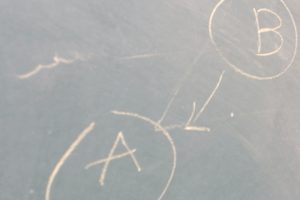The role of the college professor
The availability of information in the 21st century is unparalleled even when compared to the recent past. Students no longer need to attend universities to access knowledge they could not otherwise obtain. In this environment, the role of the professor has changed from one who “professes” privileged content to that of a guide in the processing and analyzing of information.
My principle role as a teacher is to provide students with the tools that they need to support a lifelong search for understanding of the world around them. When I am successful, my students realize that the information provided in class is not immutable canon but simply the substrate on which they hone the skills they need for a lifetime of learning. Accompanying this realization is the recognition that education does not end with the completion of a degree but is a habit of mind that must be practiced throughout their lives.
How students learn
In my experience true learning comes when students are asked to engage in a personal struggle to understand a topic. When students are confronted with new information that they must reconcile with their present body of knowledge, they can react in three different ways. The first and simplest is that they can reject the new information outright and leave their current understanding unexamined. In this case no learning has occurred even if the student can recall the details of the new information when asked. In a second case the student can assimilate the new information  selectively into their current understanding but avoid critical evaluation and reject any aspects of the new information that conflicts with their existing position. In this case the student may have expanded their cache of “knowledge” but their understanding is incomplete and genuine learning is limited. It is this second approach that I feel most students adopt in their classes. Finally, in a third case the student may use the new information to critically evaluate their current understanding and develop a new understanding of the system that synthesizes new and existing information. This final case is disruptive and may require that students reevaluate or reject previously held positions. Furthermore the student’s struggle with understanding does not end until a new understanding has been constructed, and in reality will never end until the student ceases to be exposed to new information. It is this final case that represents genuine learning and it is the perpetual application of this final case that I hope instill in my students.
selectively into their current understanding but avoid critical evaluation and reject any aspects of the new information that conflicts with their existing position. In this case the student may have expanded their cache of “knowledge” but their understanding is incomplete and genuine learning is limited. It is this second approach that I feel most students adopt in their classes. Finally, in a third case the student may use the new information to critically evaluate their current understanding and develop a new understanding of the system that synthesizes new and existing information. This final case is disruptive and may require that students reevaluate or reject previously held positions. Furthermore the student’s struggle with understanding does not end until a new understanding has been constructed, and in reality will never end until the student ceases to be exposed to new information. It is this final case that represents genuine learning and it is the perpetual application of this final case that I hope instill in my students.
What I do to promote learning
It is obviously impossible to force students to develop the habits of mind that accompany genuine learning. The best that one can do is provide an environment that simultaneously generates the type of intellectual disruptions that require reevaluation of models of understanding and provides a safe environment for students to engage in critical evaluation of their understanding.
I approach teaching as a collaborative experience in which the students use me, course materials, and their classmates as tools in their own investigation of the subject. Lecture is interwoven with case studies, oral questions, and short writing exercises. Assignments are open–ended and focused on developing and testing critical questions from collected data. The questions asked of the students, the discussion of the cases, and the writing assignments require that students compose answers that show how new information has guided their developing understanding of the topic.
Many of the classroom activities are un–graded, in which the students are encouraged to “fail early and fail often”. By allowing the students frequent opportunities to test their understanding without serious consequences to their grades, I encourage them to make frequent mistakes and to learn by reflecting on those mistakes. I have found that this course structure with frequent opportunities for constructive mistakes facilitates more inclusive learning. By requiring students to regularly communicate their understanding of the material in both written and spoken formats I empower them to guide the delivery and pace of the course to facilitate their own success. Furthermore, students with different cultural and educational experiences can bring those experiences to the their answers and therefore, the course.
Concluding remarks
I am deeply invested in undergraduate education and I approach my teaching as an integrated component of an overall philosophy of education that integrates teaching and scholarship. Through the teaching approach I describe above I expose students to thought processes and foundational information that support genuine learning about the biosphere. Through the maintenance of an active research program I expose some students directly to the process of scientific study as collaborators on my research projects, but more generally (and more importantly), active research creates an intellectual environment in which the continual reevaluation of understanding is the norm. In this environment students can develop the habits of learning that continue beyond the end of formal education.
